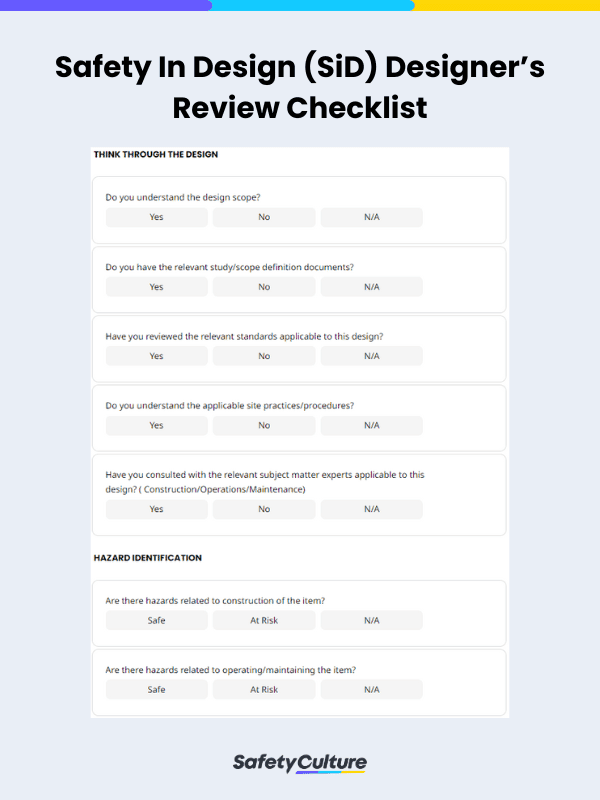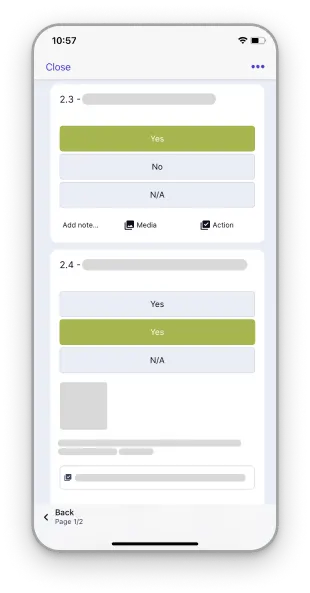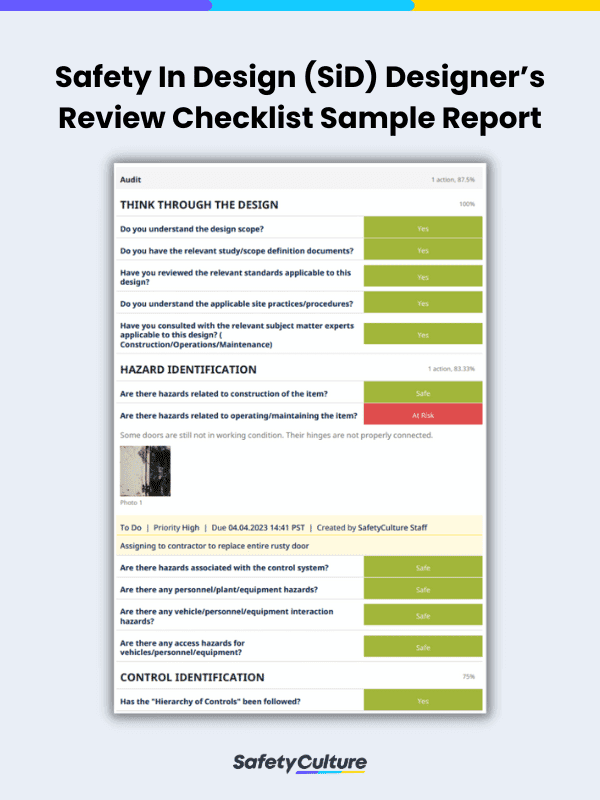What is a Safety in Design Checklist?
A Safety in Design checklist is a tool that can help process, identify, assess, and control hazards in the workplace. Often used by engineers, designers, and safety professionals, this checklist aims to ensure that safety is considered in the creation of a structure or workplace, starting from its conception all the way to its completion and implementation. The checklist includes a wide range of potential hazards, such as chemical, electrical, mechanical, and physical hazards, as well as ergonomic and environmental factors.
Importance
Safety in Design refers to the act of putting hazard identification and risk assessment at the center of a project’s design process. This is often seen in the creation of buildings, the management and ergonomics of workplaces, and the maintenance of equipment and systems.
Using a Safety in Design checklist is a very important aspect of maintaining workplace safety. Above all else, having a dedicated checklist for Safety in Design demonstrates a commitment to creating a safe working environment for everyone. By identifying and addressing potential hazards early on in the design process, organizations can prevent accidents, injuries, and even fatalities from both workers and clients or other bystanders. This not only protects personnel, but also reduces costs associated with lost productivity, medical expenses, and legal fees.
Having a Safety in Design checklist can also help organizations comply with local, state, and federal regulations. This can prevent costly fines and legal fees, which helps organizations maintain a positive reputation in their respective industry, work more efficiently, and better serve clients.
What to Include in a Safety in Design Checklist
There are many ways to create and maintain a Safety in Design checklist, as each organization and project will have different requirements that need to be considered. However, each checklist should cover the main components of Safety in Design regardless. These components are:
- Identification of Potential Hazards: The main purpose of a Safety in Design checklist is to identify and address all potential hazards associated with the product, process, or equipment being designed. Common hazards that may be considered include chemical, electrical, mechanical, and physical hazards, as well as ergonomic and environmental factors. Accompanying this should be a risk assessment process that evaluates the likelihood and severity of potential hazards. This helps prioritize the hazards that need to be addressed first and ensures that the most critical hazards are addressed early in the design process.
- Verification and Validation: The checklist should include a process to verify and validate the design and that it has control measures to effectively eliminate or control its identified hazards. This includes testing, inspection, and evaluation of the design controls.
- Design Controls: With the identification of potential hazards, the checklist should include a list of design controls that can be implemented to eliminate or control them. Examples of design controls include engineering controls, administrative controls, and personal protective equipment.
- Documentation: Your Safety in Design checklist will likely be stored as formal documentation of hazards and problems. Therefore, it is important to have your checklist signed off by the right authorized personnel for the identification of potential hazards, risk assessment, design controls, and verification and validation.
How to Use
Here is a step-by-step guide on how to integrate your Safety in Design checklist into your workflow:
- Define the scope: Determine the product, process, or equipment that the checklist will be applied. This will help to narrow down the hazards that need to be considered.
- Set an inspection date: Coordinate with other members of your team on when you will conduct an inspection of your project, workplace, or product.
- Identify hazards: Conduct a hazard analysis with your Safety in Design checklist to identify all potential hazards associated with the product, process, or equipment. This should include chemical, electrical, mechanical, and physical hazards, as well as ergonomic and environmental factors.
- Perform a risk assessment: Evaluate the likelihood and severity of each potential hazard you can find. This will help to prioritize the hazards that need to be addressed first and ensure that the most critical hazards are addressed early in the design process. List down your findings in your checklist as you go along in order to stay on track.
- Develop design controls: Develop a list of design controls that can be implemented to eliminate or control hazards. This should include engineering controls, administrative controls, and personal protective equipment.
- Verify and validate controls: Develop a process to verify and validate that the design controls effectively eliminate or control the identified hazards. This includes testing, inspection, and evaluation of the design controls.
- Document the process: Document the entire inspection process, including the identification of potential hazards, risk assessment, design controls, and verification and validation. This ensures that the process is repeatable and helps to track progress and identify areas for improvement.
Here is an example of a filled-out Safety in Design checklist report:
Improving an Existing Checklist
If you already have your own checklist, you must regularly improve it. Some ways you can do so are by doing the following:
- Review and update the checklist regularly to ensure that it reflects current hazards, hazard controls, and safety standards.
- Incorporate feedback from workers and supervisors to improve the effectiveness of the checklist.
- Use a multi-disciplinary team to ensure that all aspects of the design process are considered.
Another way you can improve your existing checklists is by moving your processes online. Use technology to streamline the checklist process and improve accuracy and efficiency. Digital checklists can also help you:
- Report issues and hazards anywhere, even remotely
- Communicate with your teammates from afar
- Create corrective actions and assign them to the right people
FAQs about Safety in Design Checklists
Both Safety in Design and Prevention through Design are concepts focused on reducing hazards in the workplace by applying risk management practices early on in a project, specifically during its design stages. “Safety in Design” is the more used term, while “Prevention through Design” is more commonly seen in a US context.
It is usually the project manager, designer, or contractor who manages the Safety in Design checklist. However, having other team members involved in the design process is also encouraged.
Although Safety in Design is often associated with building construction, it can also be applied to:
- Food
- Medicine
- Workplace ergonomics
- Engineering
- Product design




